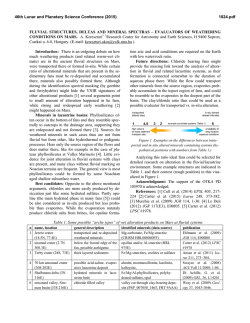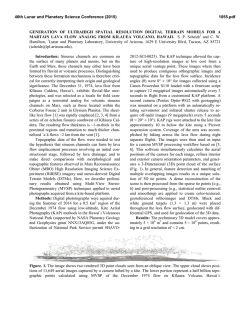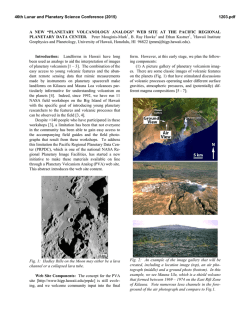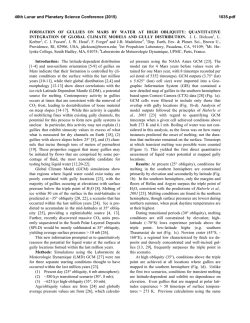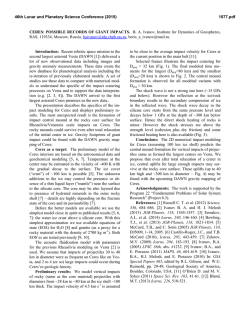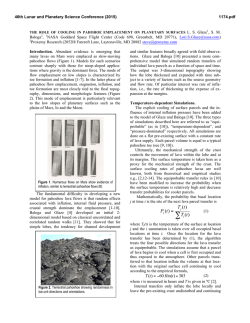
late noachian-early hesperian flood volcanism in hesperia planum
46th Lunar and Planetary Science Conference (2015) 2250.pdf LATE NOACHIAN-EARLY HESPERIAN FLOOD VOLCANISM IN HESPERIA PLANUM: LARGESCALE LAVA-ICE INTERACTIONS AND GENERATION AND RELEASE OF MELTWATER. James W. Head and James Cassanelli, Department of Earth, Environmental and Planetary Sciences, Brown University, Providence, RI 02912 USA ([email protected]). Introduction: The Late Noachian-Early Hesperian (LN-EH) represents a time of profound transition in the geologic [1], mineralogic [2] and climate [3,4] evolution of Mars characterized by a decrease in bombardment rate, evidence for water flowing across the surface (valley networks [5,6] and open-basin lakes [7]), a peak in volcanic flux [8-10], a major climate transition, and a major transition in mineralogic weathering style [2]. Two of the major processes are: 1) volcanism, representing the surface manifestation of interior evolution, and 2) fluvial, representing conditions in the atmosphere (rainfall/snowfall), and temperature at the surface/near subsurface (groundwater/cryosphere). What can the relationship between these two major processes tell us about conditions during this critical transition period? In order to address this question, we examine the type area of the Hesperian Period, Hesperia Planum (HP) (Fig. 1), a ~3 x 106 km2 area composed of extensive flood volcanic plains with two major volcanic edifices (Tyrrhenus and Hadriacus Montes) and evidence of various volatile-related processes [11-18]. Figure 1. Geologic map of the Hesperia Planum region [1]. We investigate the relationship of the emplacement of these units with the older surrounding and subjacent Noachian terrain and related incised valley networks, and contemporaneous and relatively younger fluvial channels and associated features within and adjacent to HP. We document evidence for the state of water in the LN-EH climate (liquid or solid), and further investigate the relationship of the volcanic features and deposits to fluvial features, as has been previously studied [11-13], and attributed to melting of ground ice by intrusive volcanism [11-13]. Stratigraphy and Geologic Setting: HP occupies a broad, relatively flat depression surrounded and underlain by early and late Noachian cratered highlands units [1] incised by a series of valley networks that flow from the highland margins in toward the planum interior during the LN-EH [5-6]. The earliest distinctive evidence of volcanism is Tyrrhenus Mons (TM), a Noachian [1] volcanic edifice in central HP. A second volcanic edifice, Hadriacus Mons (HM) is located in the SW part of HP. Both edifices are surrounded by Early Hesperian volcanic plains (EHVP) [1] that make up the majority of HP, and show irregular embayment relationships with the surrounding highlands and valley networks. The volcanic edifices have been interpreted to represent both explosive and effusive eruptions [19-21]; the plains are primarily high-effusion rate flood-basalt eruptions [10,15,19,22]. Both edifices are heavily dissected by radial channels, interpreted to be part of the global valley network systems [5]. Fluvial Activity: Valley networks systems in the surrounding highlands are generally embayed by lava plains, although there is evidence for late stage VN deposits superposing EHVP. Radial VN are superposed on TM and HM indicating that fluvial activity occurred during and subsequent to their formation. Similar VN distributions have been mapped on younger volcanic edifices in Tharsis and attributed to top-down and bottom-up heating and melting of superposed snow and ice deposits [6,23]. Together, these features suggest significant fluvial erosion occurring during the LN-EH, during the formation of the LN-EH edifices and the EHVP. Additional fluvial features (sinuous channels and tear-dropped-shaped islands) are found within the EHVP. Late Hesperian fluvial channels are observed on the SW margin of HP, extending down into Hellas Basin (Fig. 1). Plains Volcanic Activity and Post-Volcanic Unit Modification: The EHVP are generally smooth plains suggestive of flood basalt emplacement, intermingled with ash deposits from the HM and TM edifices [15-21]. We estimated the thickness of the EHVP by measuring the diameters of buried and partially buried impact craters throughout HP (range ~1.8-2.3 km; average ~2 km). A wide range of evidence is seen for modification of the EHVP surface during and subsequent to emplacement: 1) Wrinkle Ridges: EHVP are heavily deformed by a network of wrinkle ridges (WR), which form polygonal networks that are confined to HP itself, suggesting significant subsidence, following emplacement. 2) Collapse/Chaos: These occur inside flooded impact craters and near the margins of HP adjacent to areas of VN embayment. 3) Plateaus/Graben: Tyrrhenus Labyrinthus, an equi-dimensional ~100 km region of rectangular plateaus and graben in NW HP suggests that the EHVP surface was highly deformed inside HP, perhaps in conjunction with WR formation. 4) Linear Depressions: A broad (~25-50 km wide), several 46th Lunar and Planetary Science Conference (2015) 100 m deep, hundreds of km long trough-like depression in the EHVP surface extends from central HP to the south and contains fluvial channels and teardrop-shaped islands. 5) Channel/WR: In SW HP, several fluvial channels [5] emerge from WR structures. 6) Scalloped Flow Margins: At numerous places across HP, flow margins are largely scalloped in nature, suggesting modification of flow margins by volatile processes. Together, EHVP flood-basalt emplacement, the high degree of internal deformation of the EHVP, and associated pre-and post-emplacement fluvial activity strongly suggest a relationship between the two processes. Predicted Relationships Between Volcanism and Fluvial Activity: Two end-member models for the LNEH hydrological system and cycle are: 1) warm and wet (surface T near or >273K): dominantly vertically integrated hydrological system with surface meltwater and groundwater [24,25], and 2) cold and icy (surface T <<273K): horizontally stratified and a global cryosphere [3,4]. In the first scenario, moderate temperatures would allow rainfall and runoff, water would collect in lows, and percolate into the groundwater system; due to this, volcano-water interactions would be limited, perhaps to interaction of rising magma and groundwater in edifices producing explosive activity [20]. In the cold and icy scenario, the region would be characterized by snow and ice deposits [4] that could be up to hundreds of meters in thickness [26]; five types of volcano-H2O interactions might be envisioned: 1) Volcanic gas emissions could raise atmospheric temperature sufficiently to cause topdown melting of snow and ice [27], creating drainage channels (VN) into the lowlands; 2) Extrusive lava could interact with surface snow and ice in HP to cause melting and drainage; 3) Accumulated EHVP lava could serve to raise the melting isotherm, melting cryospheric ground ice and causing drainage into the groundwater system [28]; 4) Accumulated lava could raise the melting isotherm into surface snow and ice, causing extensive regional melting [28]; 5) Focused heat sources at HM and TM could cause localized heat pipe-drainpipe environments with snow and ice meltwater draining radially and percolating vertically near the shallow summit reservoir [29]. Because of the wide array of features suggesting shallow mass loss and associated fluvial activity, we examine the cold and icy hypothesis in detail. To illustrate the relationships between these options, we assume that a maximum of 2 km of lava is emplaced in a flood basalt mode, and track the temporal sequence of effects on surface melting and melting isotherm elevation with nominal LN-EH heat fluxes [23] (Fig. 2). The initial emplacement of lava on a ~700 m thick ice surface [26] results in contact top-down ice sheet melting, but lava thermal boundary layer thicknesses become sufficient to dampen this effect rapidly. Upon accumulation of ~1.5 km of lava, the geotherm is raised to the base of the icecemented cryosphere; the ice cement melts, and 2250.pdf percolates downward into the groundwater system. Following lava accumulation to the HP average of ~2.0 km, the melting isotherm reaches the top of the cryosphere after about 200 Ka, and begins to ascend into the surface snow and ice. Over the next several hundred thousand years, the melting isotherm ascends into the snow and ice deposit and melts it. Meltwater can either percolate into the groundwater system, or be trapped between the overlying lava and the substrate by an impermeable layer, such as a lava flow or ash layer. After about 1 My, the entire 700 m of snow and ice between the overlying lava flows and underlying regolith would be melted, producing a total of ~13 m GEL (global equivalent layer) of meltwater. Figure 2. Model results showing the thermal evolution of the cryosphere and ice sheet in response to accumlating superposed lava. Interpretation and Outstanding Questions: Formation of many of the HP features documented above suggests extensive EHVP flood-basalt resurfacing of ~2 km, accompanied/followed by subsidence, tilting, drainage and breakup across HP, suggestive of removal of many hundreds of meters of subsurface material. Associated fluvial activity seen in many instances suggests melting/drainage of significant volumes of subEHVP ice. Calculations of the thermal evolution of the EHVP emplacement predicts that the melting of icecemented cryosphere is volumetrically insufficient to account for such subsidence. Basal melting of buried ice deposits by raising H2O melting isotherms beneath superposed EHVP lava flows is the main mechanism that appears to account for 1) the predicted amount of melting, 2) the observed amount of subsidence, and 3) the evidence of associated fluvial features. References: 1] Tanaka et al. (2014) USGS. SI Map 3292; 2] Bibring et al. (2006) Science 312, 400; 3] Forget et al. (2013) Icarus 222, 81; 4] Wordsworth et al. (2013) Icarus 222, 1.; 5] Hynek et al. (2010) JGR 115; 6] Fassett & Head (2008) Icarus 195, 61; 7] Fassett & Head (2008) Icarus 198, 37; 8] Craddock & Greeley (2009) Icarus 204, 512; 9] Greeley & Schneid (1991) Science 254, 996; 10] Head & Pratt (2001) JGR 106, 12,275; 11] Squyres et al. (1987) Icarus 70, 385; 12] Crown et al. (1992) Icarus 100, 1; 13] Mest & Crown (2001) Icarus 153, 89; 14] Ivanov et al. (2005) JGR 110; 15] Gregg & Crown (2009) NASA/CP-2010-216680, 27; 16] Mest & Crown (2014) LPSC 45 2793; 17] Mest & Crown (2002) USGS GI Map I-2730; 18] Mest & Crown (2003) USGS GI Map I-2763; 19] Greeley & Spudis (1981) Rev. Geophys. 19, 13; 20] Crown & Greeley (1992) JGR Planets 98, 3431; 21] Kerber et al. (2012) Icarus 219, 358; 22] Head et al. (2006) Geology, 34, 285; 23] Fassett & Head (2007) Icarus 189, 118; 24] Craddock & Howard (2002) GRL 107, 5111; 25] Andrews-Hanna et al. (2007) Nature, 446, 163; 26] Fastook & Head (2014) PSS, in press; 27] Halevy & Head (2014) Nature Geo. 7, 865; 28] Cassanelli & Head (2015) LPSC 46; 29] Cassanelli et al. (2015) PSS, in press.
© Copyright 2026

